|
|
|
 |

 |
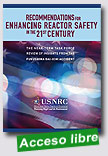 |
Recommendations for Enhancing Reactor Safety in the 21st Century - The Near Term Task Force Review of Insights from the Fukushima Dai-Ichi Accident
U.S. Nuclear Regulatory Commision (NRC), July 12, 2011, 96 p.
The Nuclear Regulatory Commission’s Japan Task Force has proposed improvements in areas ranging from loss of power to earthquakes, flooding, spent fuel pools, venting and preparedness, and said a “patchwork of regulatory requirements” developed “piece-by-piece over the decades” should be replaced with a “logical, systematic and coherent r |
egulatory framework” to further bolster reactor safety in the United States.
The report has been given to the five members of the Nuclear Regulatory Commission, who are responsible for making decisions regarding the Task Force’s recommendations.
Resumo
Extraído de:
http://www.nrc.gov/reading-rm/doc-collections/news/2011/11-127.pdf
|
 |
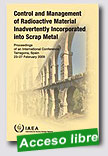 |
Control and Management of Radioactive Material Inadvertently Incorporated into Scrap Metal
IAEA Proceedings Series, 2011, 393 p.
Metal recycling has become an important industrial activity in all countries. It is seen as being socially and environmentally beneficial, because it conserves natural ore resources and saves energy. However, radioactive material may become associated with scrap metal inadvertently and, if it is melted, can cause health and economic problems as well as public acceptance issues for scrap metal. This publication is the |
proceedings of a conference organized by the Spanish Nuclear Safety Council (CSN) in cooperation with the IAEA with the aim of sharing experiences and contributing towards the resolution of problems caused by the inadvertent presence of radioactive material in scrap metal. Conclusions and recommendations were developed concerning the current situation and the future in dealing with the problems identified.
Extraído de:
http://www-pub.iaea.org/books/IAEABooks/8494/Control_and_Management_
of_Radioactive_Material_Inadvertently_Incorporated_into_Scrap_Metal |
 |
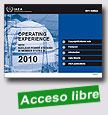 |
Operating Experience with Nuclear Power Stations in Member States in 2010 2011 Edition
IAEA, 2011, 3.069 p.
This report is the forty-second in the on operating experience with nuclear power stations in Member States. As in previous years, in addition to annual performance data and outage information, the report contains a historical summary of performance and outages during the lifetime of individual plants
|
and six figures illustrating worldwide performance and statistical data. Since 2006 the report is in an electronic version on CD-ROM which provides enhanced features for data searching and analysing.
Extraído de:
http://www-pub.iaea.org/MTCD/Publications/PDF/OPEX_2010_CD_web/PDF/OPEX_2010.pdf
|
 |
 |
The Blue Ribbon Commission on America’s Nuclear Future (BRC) was formed by the Secretary of Energy at the request of the President to conduct a comprehensive review of policies for managing the back end of the nuclear fuel cycle and recommend a new plan.
The Commission and its subcommittees met more than two dozen times between March 2010 and July 2011 to hear testimony from experts and stakeholders, to visit nuclear waste |
management facilities in the United States and abroad, and to discuss the issues identified in its Charter. A wide variety of organizations, interest groups, and individuals provided input to the Commission at these meetings and through the submission of written materials. Copies of all of these submissions, along with records and transcripts of past meetings, are available at the BRC website (www.brc.gov).
This draft report highlights the Commission’s findings and conclusions to date and articulates a preliminary set of consensus recommendations for public review and input.
Extraído de:
http://brc.gov/sites/default/files/documents/brc_draft_report_29jul2011_0.pdf
|
 |
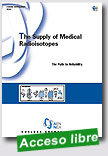 |
The Supply of Medical Radioisotopes - The Path to Reliability
Nuclear Energy Agency (NEA), 2011, 173 p.
This report provides the findings and analysis of the HLG-MR (High-level Group on the Security of Supply of Medical Radioisotopes) that would help ensure long-term supply secutiry of 99Mo/99mTc. The recommendations of the policy approach detail the essential steps to be taken by governments, industry and health community to address the vulnerabilities within the supply chain, including changing its economic structure which does not support or reinforce reliable supply.
|
In this report, the current capacity available from reactors and processors and their associated constraints are considered. It discusses work that has been done related to communicating the supply situation to downstream stakeholders, a study examining the long-term future demand of 99mTc and transport issues. The report provides a summaryof the studies done for the HLG-MR on the economic situation of the supply chain and potential 99Mo/99mTc production technologies. It also discusses findings concerning a related supply shortage of iodine-131.
Summary
Extraído de:
http://www.oecd-nea.org/med-radio/reports/med-radio-reliability.pdf |
 |
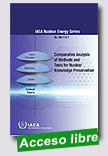 |
Comparative Analysis of Methods and Tools for Nuclear Knowledge Preservation
IAEA Nuclear Energy Series, 2011, 102 p.
This publication draws on the results of a coordinated research project (CRP) on comparative analysis of methods and tools for knowledge preservation in nuclear organizations. The CRP was initiated by the IAEA in order to enhance the capacity of Member States to maintain and preserve the information and knowledge resources related to the peaceful uses of nuclear energy. The project participants explored methods and tools used to capture, |
interpret, analyse and disseminate data and information, as well as the knowledge ultimately derived from them. Furthermore, a survey tool on the current status of knowledge preservation in nuclear and supporting organizations was developed. The analysis of the survey served as a basis for the recommendations and conclusions on good practices in knowledge preservation.
Extraído de:
http://wwwpub.iaea.org/books/IAEABooks/8394/Comparative_
Analysis_of_Methods_and_Tools_for_Nuclear_Knowledge_Preservation
|
 |
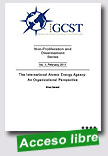
|
The International Atomic Energy Agency: An Organizational Perspective
The Global Consortium on Security Transformation (GCST), Non-Proliferation and Disarmament Series, February 2011, 32 p.
According to its Statute, the IAEA’s mandate is to promote ‘the contribution of atomic energy to peace, health, and prosperity throughout the world’ while seeking to ensure that nuclear material, equipment, facilities, and information are not used ‘to further any military purpose’ (Article II, IAEA Statute). John Stoessinger (1959, p. 403) argues that a conflict of interest is |
inherent to the IAEA’s dual mandate since there is less to prevent the Agency from attaining its ‘promotional’ goals than in ‘nonproliferation,’ which relies on the policies of governments and nuclear energy bodies at the national level. Moreover, for certain types of nuclear research and development, existing UN agencies might be better suited to perform promotional functions concerning the peaceful uses of nuclear energy for political and economic reasons. However, the IAEA’s promotional and nonproliferation activities are inextricably intertwined and underpin the Agency’s mandate (Fischer, 1997; Fischer & Szasz, 1985).
In the critically important area of safeguards, there remains no established definition of noncompliance. The term ‘non-compliance’ is used by the IAEA to describe a technical or legal ‘violation by a state of its safeguards agreement with the IAEA,’ in accordance with Article XII.C of the IAEA Statute (IAEA, 2001). Article XII.C states that the Agency’s safeguards inspectors have ‘the responsibility of. . . determining whether there is compliance with. . . conditions. . . prescribed in the agreement between the Agency and the State. . . concerned.’ The inspectors are required to report any non-compliance to the Director General who must then transmit the report to the Board of Governors. If the IAEA is unable to verify that there has been no diversion of nuclear material to weapons purposes, Article XII.C provides that the Board of Governors ‘shall report the non-compliance’ to all IAEA member states and to the UN Security Council and General Assembly. In practice, the BOG cannot make a non-compliance finding without the recommendation of the Director General. (...)
Extraído de:
http://www.securitytransformation.org/images/publicaciones/198_Non-Proliferation_Series_1_-_The_International_Atomic_Energy_Agency.pdf
|
 |
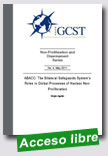 |
ABACC: The Bilateral Safeguards System’s Roles in Global Processes of Nuclear Non-Proliferation The Global Consortium on Security Transformation (GCST), Non-Proliferation and Disarmament Series, May 2011, 40 p.
The creation of the Brazilian-Argentine Agency for Accounting and Control of Nuclear Materials (ABACC) in 1991 to manage the Common System for Accounting and Control of Nuclear Material (CSAC), and the Quadripartite Agreement between Brazil, Argentina, ABACC and the International Atomic Energy Agency (IAEA), constituting a special system of safeguards, are important examples of regional contribution to global non- |
proliferation processes. Moreover, the bilateral understandings between Brazil and Argentina have had an important impact on the region, causing a domino effect that has practically led to the formation of an area free of weapons of mass destruction, or, as the Declaration of Ushuaia has labeled it, a peace zone. This system as created by the policy decisions of the two neighboring countries is a relevant and pivotal tool for discussions relating to non-proliferation and disarmament internationally and the peaceful use of nuclear technology, especially when IAEA itself and the United Nations (UN) encourage regional accounting and mechanisms for controlling nuclear material.
This paper presents the ABACC, the mechanisms of accounting and control that are currently in force, and their collaboration to the global nuclear non-proliferation processes. To do this, we begin with an analysis of Brazil and Argentina’s nuclear programs to explain the process of establishing the ABACC while contextualizing it within the internal, regional and global security situation. From this point we illustrate the ABACC structure and mechanisms for accounting and control, its work in practice, how the activities envisaged in the agreements have been implemented, how the inspections have been conducted, and how it has collaborated with IAEA. Finally, we address how the ABACC collaboration has affected the global nuclear non-proliferation processes.
Extraído de:
http://www.securitytransformation.org/images/publicaciones/209_Non-Proliferation_Series_4_-_The_Bilateral_Safeguards_Systems_Roles_in_Global_
Processes_of_Nuclear_Non-Proliferation.pdf |
 |
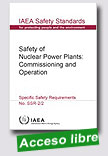 |
Safety of Nuclear Power Plants: Commissioning and Operation
IAEA Safety Standards Series, 2011, 50 p.
This publication is a revision of Safety Requirements No. NS-R-2, Safety of Nuclear Power Plants: Operation, and has been extended to cover the commissioning stage. It describes the requirements to be met to ensure the safe operation of nuclear power plants. Over recent years there have been developments in areas such as long term operation, plant ageing, periodic safety review, probabilistic safety analysis and risk informed |
decision making processes. It became necessary to revise the IAEA’s safety requirements in these areas and to correct and/or improve the publication on the basis of feedback from its application by both the IAEA and its Member States. In addition, the requirements are governed by, and must apply, the safety objective and safety principles that are established in the Fundamental Safety Principles. Contents: 1. Introduction; 2. Safety objectives and principles; 3. The management and organizational structure of the operating organization; 4. Management of operational safety; 5. Operational safety programmes; 6. Plant commissioning; 7. Plant operations; 8. Maintenance, testing, surveillance and inspection; 9. Preparation for decommissioning.
Extraído de:
http://wwwpub.iaea.org/books/IAEABooks/8524/Safety_of_Nuclear_
Power_Plants_Commissioning_and_Operation
|
| |
|
|
|
|
|
|
|
|
|
|
